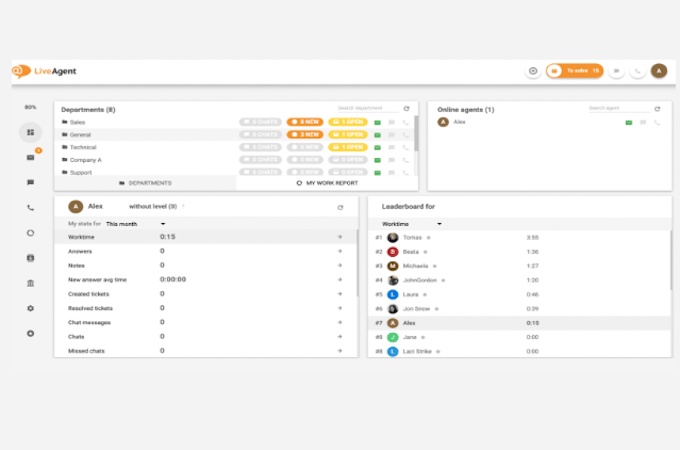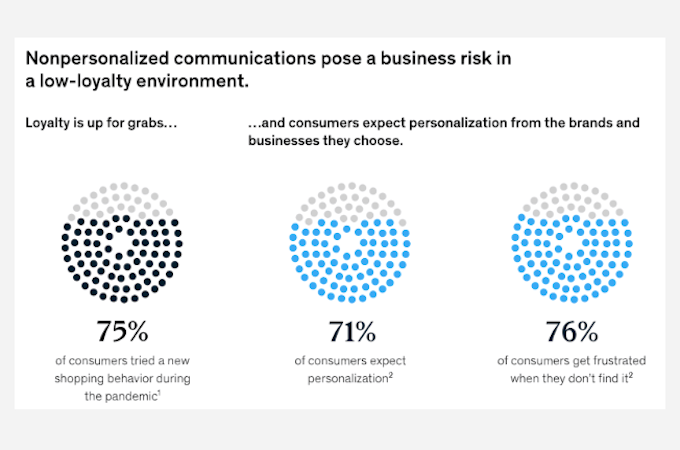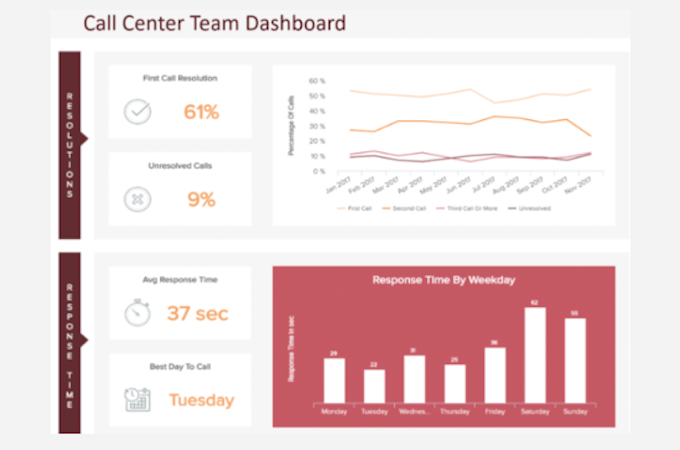Call centers are for more than just issue resolution—they’re also used to measure customer satisfaction, agent performance, and other key metrics. And because they play such an integral role in customer service, it’s critical to understand how to measure your call center’s performance.
So how exactly do you measure call center performance? Here’s a quick overview of the key metrics you should track to ensure your team is providing the best support possible.
What Is Call Center Software, and What Metrics Does It Measure?
Call center software is software used to track, manage, and measure customer support and sales interactions. It can be deployed in-house or remotely, enabling teams to work together and access customer records more quickly.
With call center software, companies can better monitor agent performance and track key customer service metrics like average handle time, first contact resolution rate, customer satisfaction (CSAT) scores, and more. It also helps you track big-picture metrics like overall customer satisfaction, issue resolution time, and more.
These metrics can help organizations identify areas for improvement and drive better customer service.

The Benefits of Measuring Call Center Software Metrics
There are many clear benefits to using call center software. Here are just a few:
Enhanced Customer Service
Customers expect personalization every step of the way. McKinsey research found that 71% of customers expect companies they buy from or do business with to know their preferences and deliver personalized experiences.

While there are a few ways to do this, call center software fits into the picture by helping you track customer interactions and preferences in real time. This makes it easier to deliver tailored support that meets customer expectations.
Improved Productivity
Call center software can help managers identify areas where agents need more training or additional support by tracking metrics like average handle time and first contact resolution rate. That way, they can make sure their team is operating at maximum efficiency.
In addition, the automated ticketing and routing features can help save time by quickly connecting customers with the right agents and departments.
Better Security
Finally, call center software provides enhanced security for your customer service data. It has a number of built-in features to protect confidential customer information and ensure compliance standards are met.
Especially if your company is in an industry where data security is of utmost importance (e.g., healthcare, finance), this is an invaluable benefit.
What Are the Most Important Call Center Metrics to Track?
No matter the vertical you operate in, there are a few universal call center metrics that should always be monitored.
Here are the most important ones.
Average Handle Time (AHT)
Average handle time (AHT) is the average amount of time it takes agents to resolve customer issues. It’s measured from when a call is received until it’s resolved and marked as “closed.”
AHT is so important because it’s a great indicator of agent productivity. Keeping AHT low helps to ensure your customers are receiving timely service and that agents aren’t overloaded with work.
For example, if you find that your AHT is increasing, it could be a sign that agents need additional training or support. In this instance, you would likely want to talk to your employees about how you could help reduce AHT, such as automation or additional staff.
First Contact Resolution (FCR) Rate
First contact resolution rate is the percentage of customer service inquiries that are resolved on the first try. It’s a measure of how well agents are able to resolve customer issues quickly, efficiently, and with minimal effort from the customer.
A high FCR rate indicates that agents are doing a great job of answering inquiries and resolving issues the first time. If you find your FCR rate to be low, it could indicate that there’s an issue with agent training or customer service processes.
By optimizing your customer service strategy in the areas where FCR is low, you can help reduce customer effort and improve their overall experience.
Customer Satisfaction (CSAT) Score
Companies can measure their customer satisfaction in a number of ways, but one of the most popular is through CSAT scores. This metric measures how satisfied customers are with their experience by asking them to rate certain aspects on a scale from 1-10 (or another variation).
With this data, businesses can see exactly what areas customers are happy and unhappy with so they can make improvements accordingly.
Call Abandonment Rate
The call abandonment rate is the percentage of customer service calls that are terminated before being answered by an agent. This metric provides valuable insight into how long customers are willing to wait for assistance.
By tracking call abandonment, businesses can identify areas where they need to improve their customer experience, such as reducing hold times or adding more agents during peak hours.
Average Time In Queue
If your customers are waiting for a long time to get the help they need, they won’t be happy. We’ve all been there, and it definitely isn’t any fun.
According to 83% of consumers, one of the most important factors in customer service is how quickly they can be connected to an agent. By monitoring this key metric, companies can ensure that their customers aren’t waiting too long.
Service Level
This metric lets you know how productive your agents are based on the percentage of calls they answer within a certain time period (usually a number of seconds). If you find that your agents are failing to meet the predetermined service level, it could indicate a need for additional training or support.
It’s also important to note that having too high of a service level can be damaging as well. When agents rush to answer calls in time, they could be overlooking important steps or neglecting customer needs.
Agent Productivity
Agent productivity can be measured in a few different ways:
- The number of calls they take, the number of emails they respond to, or their sales conversions
- The amount of time they spend on each call or task
- How often they handle customer inquiries without needing to escalate them
What’s important here is to measure the outcome of their efforts, not just the effort itself. This way, you’ll know if your agents are being productive or just going through the motions.
How to Track Call Center Metrics
Most call center software solutions have built-in reporting and analytics capabilities that can help you track and monitor all of these metrics. The reports will provide valuable insight into how your agents are performing, so you can make decisions to improve the customer experience.
That said, some metrics cannot be tracked through software. For example, you’ll need to measure customer satisfaction through surveys or interviews manually. Software can help automate the process by prompting customers to leave a review or feedback after being helped, but you may still need to manually tally up the responses.

Other metrics like AHT and first contact resolution rate are a bit more straightforward, as they’re based on call data that can be collected in the software and visualized quickly.
Best Practices for Tracking Call Center Metrics
Of course, tracking these metrics is only half the battle. You’ll need to use them the right way if you want to make meaningful changes that will benefit customers and improve your business operations.
Here are a few best practices to keep in mind.
Set realistic goals for your call center
Your call center metrics should be based on concrete goals that you can hold your agents accountable for, such as reducing the average time in queue or increasing customer satisfaction.
But they should also be realistic—don’t set the bar too high or you risk burning out your agents.
To determine what goals are realistic for your call center, the best thing to do is to get feedback from your customers and your agents. Collaborate with your agents on what they think is achievable, cross-reference the feedback you get with industry standards and business-specific data, and use this data to set realistic goals.
Don’t forget to look at the big picture
At the end of the day, metrics are just numbers. They’re numbers that should be used to inform your decisions, but they aren’t the only thing you should consider.
When evaluating metrics, take a holistic approach. Consider how all of the data points interact with each other and what kind of impact these interactions have on your call center operations.
For example, increasing agent productivity might come at the expense of customer service—this is common in contact centers where agents are expected to take more calls or handle more emails in less time.
One call center employee might end up taking more calls, but the customer experience could suffer as a result. Or you might find that agents are spending too much time on each call and not enough time helping customers.
By looking at the big picture, you can identify these issues before they become major problems.
Talk with your contact center support team regularly
We’re all human, and since your contact center team will be in a human-facing role, it’s important to talk with them regularly.
This will give you a better understanding of what agents are experiencing on the job, which can help inform your decisions in terms of call center metrics and goals. It also gives your agents an opportunity to voice any issues they may have and helps create an open line of communication between managers and agents.
Have a clear onboarding process that outlines your metrics and expectations
Your call center’s success is determined by the quality of your agents, and training plays a major role in that quality.
By having a clear and consistent training program, you can ensure that all agents are receiving the same level of instruction on how to handle customer inquiries. This will help them become more productive and efficient over time, which will have a positive impact on your call center metrics.
Here are a few tips for creating a solid training program:
- Start by creating a comprehensive onboarding process that outlines the basic expectations for customer service agents.
- Create a detailed training plan to teach your agents about call center operations and technology. Include classes on customer service best practices and the use of call center software.
- Educate your team on the company’s core values, customer service policies, and any relevant tools or technologies that are being used.
- Show your customers what some of the common call center metrics are, such as average call length or customer satisfaction scores.
- Give them the opportunity to shadow current employees and ask questions about their experience.
- Encourage them to practice on the job by simulating customer interactions in a safe environment.
By taking the time to create an effective onboarding process, you can ensure that your agents are equipped with the skills and knowledge needed to succeed in their roles.
Track and analyze call center metrics over time
Call center metrics such as customer satisfaction scores, average call length, and the number of calls handled per hour can be used to measure the performance of your agents.
But it’s important to track and analyze these numbers over time in order to gain a better understanding of how your contact center is performing.
For instance, noticing a sudden dip in customer satisfaction scores means that something has changed—you might find that the underlying issue was something within your control, such as an unclear onboarding process or a lack of training.
By tracking and analyzing call center metrics over time, you can make informed decisions that will help improve the overall performance of your contact center support team.
Final Thoughts About Call Center Metrics
When it comes to creating a personalized customer experience and optimizing your contact center operations, tracking and analyzing call center metrics is a key part of the process.
By looking at the big picture, regularly talking with your agents, having a clear onboarding process that outlines expectations, and tracking data over time, you can make sure your team is equipped to provide efficient customer support and reach those high-level goals.
So don’t fear the numbers—embrace them and use them to your advantage!
